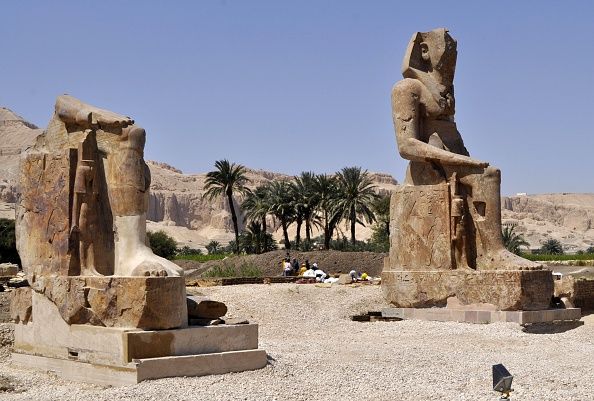
A construction operation in an Egyptian parking lot unearthed something unexpected—a fragment from an ancient statue of King Amenhotep III.
The fragment was discovered in Akhmim, a city in Upper Egypt's Sohag governorate. It comprises part of the base of a statue, showing the left foot and part of the right. The Ministry of Antiquities stated that the fragment has been verified as a historical artifact, according to the Egypt Independent. The right foot of the statue features hieroglyphic symbols that correspond to both the birth name and coronation of King Amenhotep III.
The fragment is made of black granite and shows the King posed with his left foot forward, the traditional stance in which ancient Egyptian Kings were depicted, ministry chairman Gamal Abdel said, according to the Egypt Independent. No comment was made as to the whereabouts of the statue the fragment belongs to. More statues representing King Amenhotep III have been discovered than of any other pharaoh—around 250, according to Egypt Today.
The extent of King Amenhotep III's wealth, as well as his talent for diplomacy, was documented in some of the earlier examples of the Amarna Letters, hundreds of cuneiform-inscribed clay tablets that recorded the king's negotiations with other powers and his lavish gifts of gold, according to PBS. The letters also document the reign of his son, Amenhotep IV, and the opulence for which Egypt was known during its Eighteenth Dynasty, according to the Metropolitan Museum of Art.
Amenhotep III was the ninth king of ancient Egypt's Eighteenth dynasty. He was born around the year 1388 B.C. and was buried in the Valley of the Kings, according to Egypt Today. The son of Thutmose IV, he took power at the age of 12, and his reign was marked by peace, diplomacy and the prosperity of the arts, according to PBS. He ruled for 38 years alongside his wife, Queen Tiye, one of the most powerful and influential women in ancient Egypt's history, according to Ancient Origins.
The two were grandparents to perhaps Egypt's most famous ruler, King Tutankhamun, the "boy king" who ruled Egypt from 1333 B.C. to 1324 B.C. In 2011, fragments from a double statue of King Amenhotep III and Queen Tiye showing parts of their wigs' extremities—including one of Tiye's feet—were discovered in Luxor, according to Live Science.
The fragment has since been moved to Sohag Museum, where it will undergo restoration work.
Uncommon Knowledge
Newsweek is committed to challenging conventional wisdom and finding connections in the search for common ground.
Newsweek is committed to challenging conventional wisdom and finding connections in the search for common ground.
About the writer
Kastalia Medrano is a Manhattan-based journalist whose writing has appeared at outlets like Pacific Standard, VICE, National Geographic, the Paris Review Daily, ... Read more
To read how Newsweek uses AI as a newsroom tool, Click here.








